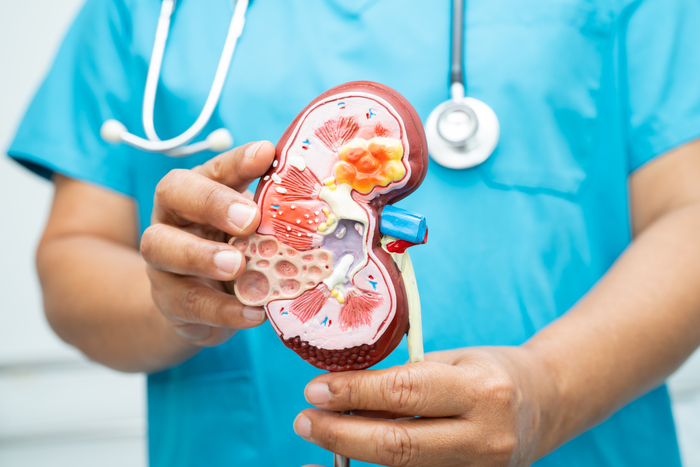Key points
- Kidney disease begins when kidneys stop functioning effectively, leading to a decline in their ability to filter waste and excess fluids from the blood.
- Chronic Kidney Disease (CKD) is a long-term condition characterized by a gradual loss of kidney function over time, often due to underlying health issues such as diabetes or hypertension.
- Kidney diseases encompass a diverse range of conditions that can affect kidney function in various ways, including Polycystic Kidney Disease, Lupus Nephritis, Interstitial Nephritis, and Diabetic Nephropathy.
- While there is no cure for kidney disease, proactive management through lifestyle changes, medication, and regular monitoring can help slow the progression of the disease and improve the well-being of those affected.

Kidney disease is a serious condition that the National Institute of Diabetes and Digestive and Kidney Diseases explains begins when your kidneys stop functioning effectively, leading to a gradual decline in their ability to filter waste and excess fluids from the blood. While there is currently no cure for kidney disease, various treatment options are available that can help manage symptoms and support a healthier life. Understanding the symptoms and potential interventions is crucial for those affected, as early detection and appropriate care can significantly improve quality of life and overall health outcomes.
What is chronic kidney disease?
Chronic Kidney Disease (CKD) is a long-term condition characterized by a gradual loss of kidney function over time, according to the National Kidney Foundation. They explain that the kidneys play a vital role in filtering waste products and excess fluids from the blood, and when their functionality diminishes, it can lead to a buildup of harmful substances in the body. CKD is often a progressive disease that can result from various factors, including diabetes, high blood pressure and certain genetic conditions. As the disease progresses, individuals may experience a range of symptoms, including fatigue, swelling in the legs and ankles, changes in urination patterns and high blood pressure. In its later stages, CKD can lead to kidney failure, requiring dialysis or a kidney transplant to sustain life.
While there is no cure for CKD, proactive management through lifestyle changes, medication and regular monitoring can help slow the progression of the disease and improve the well-being of those affected. Recognizing the importance of kidney health and seeking timely medical advice can make a significant difference in the journey of living with chronic kidney disease.
What are kidney functions?
The kidneys are vital organs that perform a range of essential functions to maintain overall health and well-being, according to the Kidney Foundation. Located on either side of the spine just below the rib cage, these bean-shaped organs play a critical role in regulating various bodily processes — including:
-
Balance water and minerals in the body.
-
Remove waste products from the blood.
-
Produce renin, which helps regulate blood pressure.
-
Synthesize an active form of vitamin D, essential for bone health.
-
Filter all the blood in the body approximately every 30 minutes.
-
Regulate the body’s acid-base balance to maintain pH levels.
Types of kidney disease
Kidney diseases encompass a diverse range of conditions that can affect kidney function in various ways, according to the Kidney Foundation. Understanding the different types of kidney disease is essential for recognizing symptoms and seeking appropriate treatment:
-
Polycystic Kidney Disease (PKD): A genetic disorder characterized by the formation of numerous cysts in the kidneys, leading to enlarged kidneys and impaired function over time.
-
Lupus Nephritis: A complication of systemic lupus erythematosus (SLE), this condition occurs when the immune system attacks the kidneys, causing inflammation and potential damage.
-
Interstitial Nephritis: An inflammation of the kidney's tubules and surrounding structures, often caused by medications, infections or autoimmune diseases, leading to impaired kidney function.
-
Glomerulonephritis: A group of diseases that cause inflammation of the glomeruli, the filtering units of the kidneys, which can result in blood and protein in the urine and reduced kidney function.
-
APOL1-Mediated Kidney Disease: Linked to specific genetic variants in the APOL1 gene, this condition is more prevalent in individuals of African descent and can lead to kidney damage, particularly in cases of hypertension and diabetes.
-
Diabetic Nephropathy: A complication of diabetes that affects the kidneys' ability to filter waste, often resulting in progressive kidney damage and increased risk of kidney failure.
-
Chronic Kidney Disease (CKD): A long-term condition characterized by a gradual loss of kidney function, often due to underlying health issues such as diabetes or hypertension.
Kidney disease stages
Kidney disease progresses through five distinct stages, each characterized by varying degrees of kidney function and specific symptoms. The Kidney Foundation notes that early detection and intervention can significantly slow the progression of the disease, making it essential to recognize the signs and understand the implications of each stage. Below is an overview of the five stages of kidney disease:
Stage 1 kidney disease
In this initial stage, kidney function is normal or only mildly reduced, typically with a glomerular filtration rate (GFR) of 90 mL/min or more. Individuals may not experience noticeable symptoms, but there may be signs of kidney damage, such as protein in the urine or structural abnormalities detected through imaging.
Stage 2 kidney disease
At this stage, there is a mild decrease in kidney function, with a GFR between 60 and 89 mL/min. While symptoms are still generally absent, routine monitoring is important to track any changes in kidney health and manage risk factors like high blood pressure or diabetes.
Stage 3 kidney disease
Stage 3 is divided into two sub-stages: 3a (GFR of 45-59 mL/min) and 3b (GFR of 30-44 mL/min). In this stage, moderate kidney damage occurs, and individuals may begin to experience symptoms such as fatigue, swelling and changes in urination. Management becomes increasingly critical to slow progression.
Stage 4 kidney disease
At this advanced stage, kidney function is severely reduced, with a GFR of 15-29 mL/min. Symptoms become more pronounced, and individuals may experience complications such as anemia, bone disease and fluid retention. Preparation for dialysis or kidney transplantation often begins during this stage.
Stage 5 kidney disease
Also known as end-stage renal disease (ESRD), Stage 5 occurs when the GFR drops below 15 mL/min, indicating that the kidneys can no longer function effectively. Individuals typically require dialysis or a kidney transplant to survive. Symptoms are severe, and comprehensive care is essential to manage health and quality of life.
Kidney disease symptoms
Many individuals may not notice symptoms in the early stages, making regular check-ups and awareness of potential warning signs essential. As kidney function declines, various symptoms may arise, reflecting the body's struggle to maintain balance and eliminate waste, according to the CDC. Here are some common symptoms associated with kidney disease:
-
Nausea: A feeling of sickness that can lead to vomiting, often caused by the buildup of toxins in the bloodstream.
-
Vomiting: Frequent vomiting may occur as the body attempts to rid itself of waste products.
-
Loss of Appetite: A decreased desire to eat can result from metabolic changes and the accumulation of waste.
-
Fatigue and Weakness: Persistent tiredness and a lack of energy are common as the kidneys fail to filter toxins effectively.
-
Sleep Problems: Difficulty sleeping can arise from discomfort, restless legs or the need to urinate frequently at night.
-
Urinating More or Less: Changes in urination patterns, including increased frequency or reduced output, may indicate kidney issues.
-
Muscle Cramps: Imbalances in electrolytes can lead to painful muscle cramps and spasms.
-
Swelling of Feet and Ankles: Fluid retention due to impaired kidney function can cause swelling in the lower extremities.
-
High Blood Pressure (Hypertension): The kidneys play a crucial role in regulating blood pressure, and kidney disease can lead to elevated blood pressure levels.
-
Shortness of Breath: Fluid buildup in the lungs or anemia can cause difficulty breathing.
-
Chest Pain: This may occur due to fluid overload or other cardiovascular complications related to kidney disease.
-
Itchy Skin: Accumulation of waste products can lead to persistent itching.
-
Changes in Skin Color: A pale or sallow complexion may result from anemia or other metabolic changes.
What causes kidney disease?
According to the National Kidney Foundation, there are various factors that can contribute to the development of kidney disease, often leading to a gradual decline in kidney function. Some causes are related to underlying health conditions, while others may stem from anatomical or environmental factors. Identifying these causes can help individuals take proactive steps to protect their kidney health:
-
Type 1 or Type 2 Diabetes: Both forms of diabetes can lead to diabetic nephropathy, a condition where high blood sugar levels damage the kidneys' filtering units over time.
-
High Blood Pressure: Hypertension can cause damage to blood vessels in the kidneys, impairing their ability to filter waste effectively and leading to further health complications.
-
Glomerulonephritis: This group of diseases causes inflammation of the glomeruli, the filtering units of the kidneys, which can result from infections, autoimmune diseases or other conditions.
-
Interstitial Nephritis: An inflammation of the kidney's interstitial tissue, often caused by medications, infections or autoimmune disorders, leading to impaired kidney function.
-
Prolonged Obstruction of the Urinary Tract: Conditions such as kidney stones, tumors or an enlarged prostate can obstruct urine flow, causing pressure buildup and potential kidney damage.
-
Vesicoureteral Reflux: This condition occurs when urine flows backward from the bladder into the kidneys, increasing the risk of kidney infections and damage.
-
Recurrent Kidney Infection: Frequent urinary tract infections (UTIs) can lead to chronic kidney infection, causing scarring and damage to the kidneys over time.
-
Genetic Disorders: Certain inherited conditions, such as polycystic kidney disease, can predispose individuals to kidney disease due to structural abnormalities in the kidneys.
Risk factors for kidney disease
According to the National Kidney Foundation, certain lifestyle choices, medical conditions and genetic predispositions can significantly increase the likelihood of developing kidney disease. Being aware of these risk factors can help individuals take proactive measures to protect their kidney health and seek timely medical advice when necessary:
-
Diabetes: Both Type 1 and Type 2 diabetes can lead to kidney damage over time, making it one of the leading causes of kidney disease.
-
High Blood Pressure: Chronic hypertension can damage blood vessels in the kidneys, impairing their ability to function properly.
-
Cardiovascular Disease: Conditions affecting heart health can also impact kidney function, as the two systems are closely linked.
-
Smoking: Tobacco use can harm blood vessels, reducing blood flow to the kidneys and increasing the risk of kidney disease.
-
Obesity: Excess body weight is associated with diabetes and hypertension, both of which are significant risk factors for kidney disease.
-
Family History of Kidney Disease: A genetic predisposition can increase the likelihood of developing kidney disease, especially if close relatives have been affected.
-
Abnormal Kidney Structure: Congenital abnormalities or structural issues with the kidneys can predispose individuals to kidney disease.
-
Frequent Use of Medications That Can Damage the Kidneys: Long-term use of certain medications, such as nonsteroidal anti-inflammatory drugs (NSAIDs) and some antibiotics, can lead to kidney damage.
-
Age: The risk of kidney disease increases with age, as kidney function naturally declines over time.
-
Dehydration: Chronic dehydration can strain the kidneys and increase the risk of kidney damage, especially in individuals with other risk factors.
Kidney disease prevention tips
By making informed lifestyle choices and staying vigilant about potential risk factors, individuals can significantly reduce their chances of developing kidney-related issues. Here are some effective prevention tips for kidney disease according to the National Kidney Foundation:
-
Keep a Healthy Weight: Maintaining a healthy weight through a balanced diet and regular exercise can help prevent conditions such as diabetes and hypertension, which are major risk factors for kidney disease.
-
Avoid Smoking: Quitting smoking can improve overall cardiovascular health and enhance blood flow to the kidneys, reducing the risk of kidney damage.
-
Keep Track of Your Health with Your Doctor: Regular check-ups and monitoring of kidney function, especially for those with risk factors, can help detect any issues early. Discussing any changes in health and following your doctor’s recommendations is crucial for effective management.
-
Stay Hydrated: Drinking adequate amounts of water helps maintain kidney function by flushing out toxins and preventing dehydration, which can strain the kidneys.
Kidney disease treatment
While there is no cure for kidney disease, various strategies can help slow its progression, manage symptoms, and address complications, notes the National Kidney Foundation. Treatment options vary depending on the stage of the disease, underlying causes, and individual patient needs. Some common treatment options for kidney disease include:
Treating the causes
Addressing the underlying causes of kidney disease is crucial. This may involve managing diabetes and high blood pressure through lifestyle changes and medications, as well as monitoring and treating conditions such as glomerulonephritis or urinary tract obstructions.
Treating the complications
Kidney disease can lead to several complications, including anemia, bone disease and electrolyte imbalances. Treatment may involve medications to manage these issues, such as erythropoiesis-stimulating agents for anemia or phosphate binders for mineral imbalances.
Kidney dialysis
For individuals with advanced kidney disease or kidney failure, dialysis may be necessary. This treatment involves using a machine to filter waste products and excess fluids from the blood, either through hemodialysis (using a machine) or peritoneal dialysis (using the lining of the abdomen).
Kidney transplant
A kidney transplant is a surgical procedure that involves replacing a diseased kidney with a healthy one from a donor. This option is often considered for individuals with end-stage renal disease who are eligible and willing to undergo the procedure, offering the potential for improved kidney function and quality of life.
Lifestyle modifications
In addition to medical treatments, lifestyle changes such as adopting a kidney-friendly diet, exercising regularly and avoiding nephrotoxic substances (like certain medications and alcohol) can significantly impact kidney health and overall well-being.
FAQs
What is Chronic Kidney Disease (CKD) and what are its symptoms?
Chronic Kidney Disease (CKD) is a long-term condition characterized by a gradual loss of kidney function over time. Symptoms can include fatigue, swelling in the legs and ankles, changes in urination patterns, and high blood pressure. In its later stages, CKD can lead to kidney failure, requiring dialysis or a kidney transplant to sustain life.
What functions do the kidneys perform in the body?
The kidneys perform a range of essential functions to maintain overall health and well-being. These include balancing water and minerals in the body, removing waste products from the blood, producing renin to regulate blood pressure, synthesizing an active form of vitamin D for bone health, filtering all the blood in the body approximately every 30 minutes, and regulating the body’s acid-base balance to maintain pH levels.
What are the different types of kidney diseases?
Kidney diseases include conditions such as Polycystic Kidney Disease (PKD), Lupus Nephritis, Interstitial Nephritis, Glomerulonephritis, APOL1-Mediated Kidney Disease, Diabetic Nephropathy, and Chronic Kidney Disease (CKD). Each of these conditions can affect kidney function in different ways and have varying symptoms and treatment options.
What are the stages of kidney disease?
Kidney disease progresses through five distinct stages, each characterized by varying degrees of kidney function and specific symptoms. These stages range from Stage 1, where kidney function is normal or only mildly reduced, to Stage 5, also known as end-stage renal disease (ESRD), where the kidneys can no longer function effectively and individuals typically require dialysis or a kidney transplant to survive.
What are the treatment options for kidney disease?
While there is no cure for kidney disease, treatment options can help slow its progression, manage symptoms, and address complications. These can include addressing the underlying causes of kidney disease, treating the complications, kidney dialysis, kidney transplant, and lifestyle modifications such as adopting a kidney-friendly diet, exercising regularly, and avoiding substances that can harm the kidneys.









